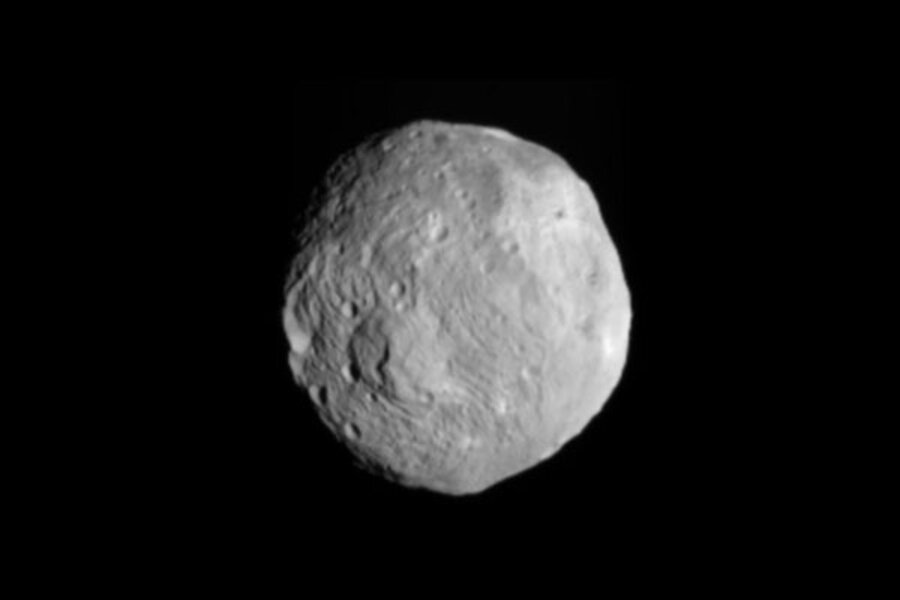NASA mission confirms: Ex-asteroid Vesta is a planet that almost was
Loading...
The one-time asteroid – now “protoplanet” – Vesta is living up to its billing as a planet wannabe with a case of arrested development.
Data from NASA's DAWN mission to Vesta, and later to another protoplanet, Ceres, have essentially confirmed the broad outlines of Vesta's history and structure, initially inferred from meteorites thought to be chips off the old protoplanet.
But the details are providing surprises – from the unexpectedly young age of its largest impact basin to the height of the mountain that sits at the center of the basin. Measurements by the orbiter DAWN mark it as the second highest mountain, base to peak, in the solar system after Mars' Olympus Mons volcano.
“Vesta's history seems to be more similar to the rocky, terrestrial planets than to its larger sibling, the dwarf planet Ceres,” said Carol Raymond, DAWN's deputy lead scientists and a co-author of one of six research papers detailing the results in Friday's issue of the journal Science.
Formed within the first 2 million years after the sun's disk of dust and gas began to form solid clumps, Vesta is “a key witness to the events at the very beginning of the solar system,” she said at a NASA briefing Thursday. “We believe Vesta is the only intact member of a family of similar bodies that have since perished.”
The others were broken up in collisions that helped formed the asteroid belt, a broad expanse of space rubble that orbits the sun between Mars and Jupiter. Vesta and Ceres both orbit the sun among these “main belt” asteroids.
Astronomers have matched telescopic data on Vesta's mineral composition to that of a class of chemically similar meteorites known by its initials HED and a group of asteroids known as Vestoids. DAWN's close-in analysis confirms the Vesta-HED meteorite link, notes Harry McSween, a researcher at the University of Tennessee who heads the mission's surface-composition working group.
Detailed gravity measurments show Vesta as a layered body with an iron core, a mantle made of silicate rocks, and a crust largely consisting of volcanic rock known as basalts – essentially the same structure as the four inner planets – Mercury, Venus, Earth, and Mars – as well as the moon. The iron core is about 140 miles across and accounts for about 18 percent of Vesta's mass.
These measurements confirm modeling estimates for Vesta based on analyses of the HED meteorites. This means scientists can be more confident about the inferences they make on conditions in the early solar system based on the meteorite studies, Dr. Raymond says.
Although Vesta has emerged intact from the relentless collisions that formed the asteroid belt, it still bears the geological scars from collisions. Indeed, Vesta is serving as a record book detailing the collision history within the solar system, says David O'Brien, a researcher at the Planetary Science Institute in Tucson, Ariz., and another member of the DAWN team.
Researchers have built a catalog of some 2,000 craters wider than 2-1/2 miles, including seven large impact basins – hard to spot because the surface has been so worked-over by lesser, but more recent impactors.
Detailed maps built from DAWN's data show two enormous impact basins – Rheasilvia and Venenian – scarring a large swath of Vesta's southern hemisphere. Rheasilvia's basin measures about 300 miles across, with the Venenian basin spanning some 200 miles. All on a protoplanet only about 325 miles in diameter. By counting craters within the basins, researchers estimate that Rheasilvia is only about 1 billion years old. Venenian, which partially underlies Rheasilvia, is at least 2 billion years old, Dr. O'Brien says.
“The relatively young ages for these basins stand in stark contrast to what we find on the moon,” he says. All of the impact basins there are at least 3.5 billion years old. This indicates that the collision environment each inhabits “is surprisingly different." The story the difference tells is complicated, he says, one “we're only beginning to unravel.”
Sitting in the middle of the Rheasilvia Basin is a central mound that rises roughly 16 miles above the basin floor. Measurements of the mountain show it take up one-third of the crater's diameter.
“At first this was very surprising,” O'Brien says. Large craters on the moon or on other bodies don't look like Rheasilvia. But craters on moons in the outer solar system can have similar structures. In essence, he says, such craters form when the size of the crater is almost as large as the body it sculpts. He estimates that the impact excavated enough material to fill the Grand Canyon 1,000 times over – or roughly 250,000 cubic miles of debris.
Much of that fell back to repave Vesta's southern hemisphere, where no crater beyond Venenian's is older than 1 billion years.
That leaves Vesta's northern hemisphere as the repository for information on its geological history reaching farther back in time. In late April, DAWN scientists received approval from NASA to remain at Vesta for an extra 40 days before heading for a rendezvous with Ceres in February 2015. Up to now, sunlight has illuminated the southern half of Vesta. With the extension, the sun will increasingly shine on the northern hemisphere, giving the team a chance to extend their data to the once-dark side of the protoplanet.







